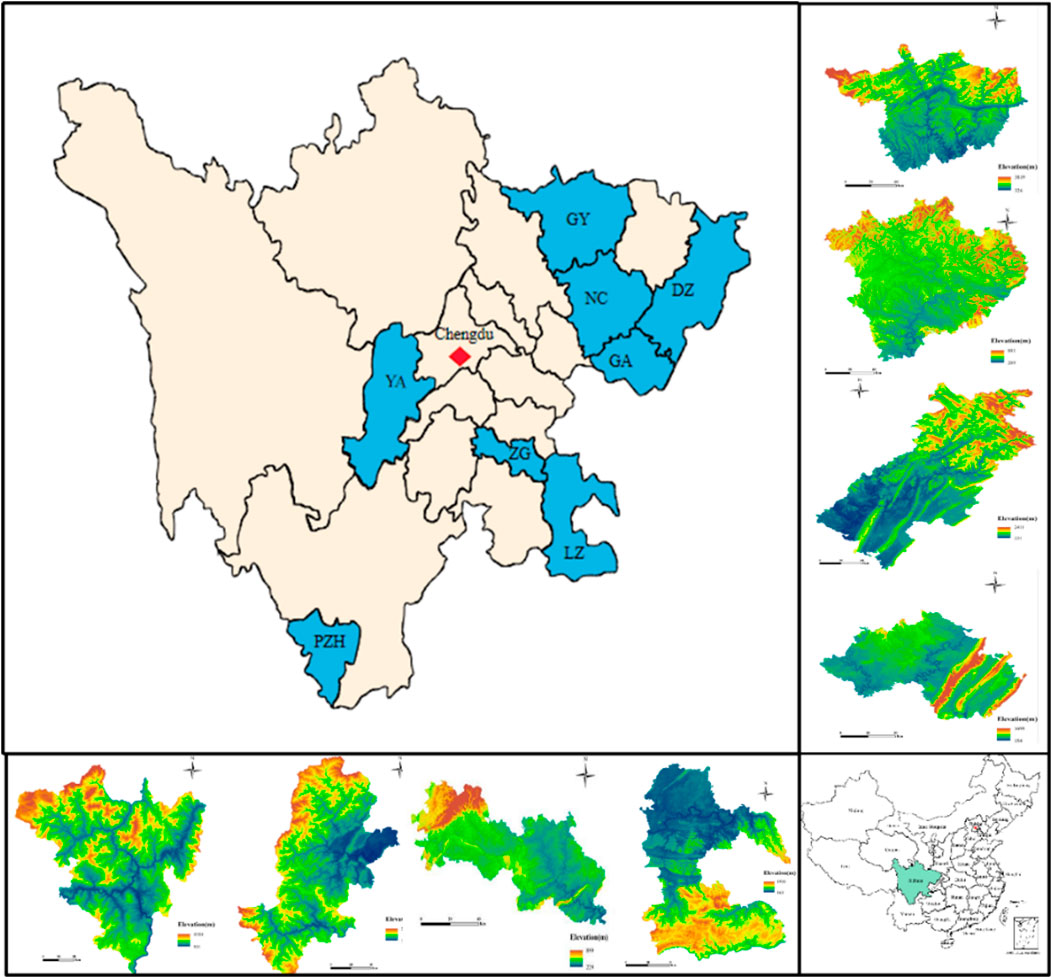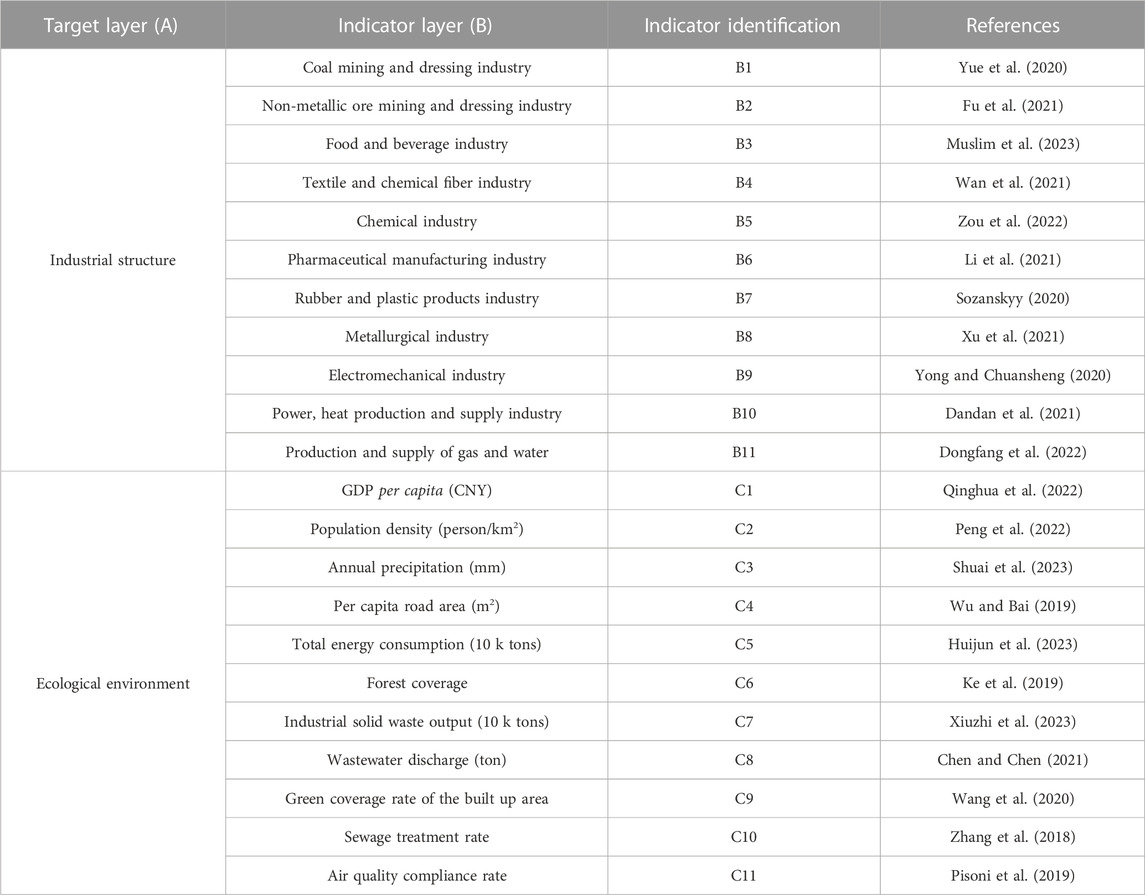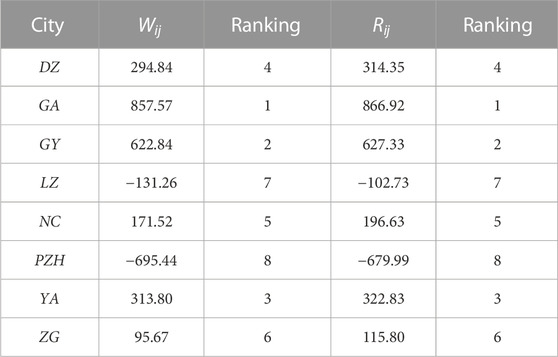- 1College of Earth Sciences, Chengdu University of Technology, Chengdu, China
- 2Geomathematics Key Laboratory of Sichuan Province, Chengdu University of Technology, Chengdu, China
- 3College of Management Science, Chengdu University of Technology, Chengdu, China
- 4College of Mathematics and Physics, Chengdu University of Technology, Chengdu, China
During their journey of developing, resource-based cities gradually deplete the resources on which they rely for survival. Scientific and reasonable research on the industrial and ecological aspects of resource-based cities is conducive to the coordinated development of cities. In order to further analyze the industrial structure of resource-based cities systematically and analyze the comprehensive level of resource-based cities from multi-dimensional perspective. This paper took 8 resource-based cities in Sichuan Province as the research object, and constructed the index system from two systems: industrial structure and ecological environment, then the shift-share analysis, entropy weight method and capacity coupling coefficient model were used to analyze their level of industrial structure, ecological environment and the coupling relationship respectively. According to the results of the study, it can be concluded that the main influencing factor in the development of industrial structure is the industrialmix effect, while the ecological level presents a decreasing level due to the lack of control of total industrial solid waste and energy consumption. The coupling degree between industrial structure and ecological environment in resource-based cities in Sichuan Province is relatively stable, and the coupling coordination degree also gradually tends to a stable state. In the subsequent development, the focus should be on the coal mining and dressing industry and the power, heat production and supply industry. Starting with the actual industrial structure of resource-based cities and specific indicators that affected the ecological environment, this paper hereby analyzed the development momentum and unified and coordinated development status of resource-based cities. The main purpose of this paper is providing some technical support for resource-based cities to improve their coordinated urban development, and giving policy suggestions for the coordinated development of resource-based cities.
1 Introduction
A resource-based city is a city where the extraction and processing of natural resources are taken as the leading industry and an industrial chain is formed (Zongrun et al., 2023). However, the development of resource-based cities is accompanied by problems such as excessive consumption of natural resources, environmental damage and poor sustainable economic development (Xing et al., 2021). In this case, the way to balance the two aspects of industrial structure and ecological environment Yuan et al. (2022) and form a complete circular economy system to promote the coordinated development of resource-based cities (Han et al., 2021) has gradually become a focus of attention for scholars worldwide.
In terms of industrial structure in resource-based cities, most studies have concluded that the adjustment of industrial structure in resource-based cities can be approached from two perspectives: to refine resource-based industries (Li et al., 2022) and to cultivate non-resource-based industries (Malin et al., 2023; Yang et al., 2023). In terms of resource-based industries, some scholars have found that the high proportion of resource-based industries is the key to the poor coordinated development of resource-based cities (Wang, 2022). The reason is that resource-based industries tend to gradually lead to a single industrial structure and labor type in cities (Ruyin et al., 2021), as evidenced by the practice of Taiyuan City in resource-based cities (Wang et al., 2021). However, some scholars have expressed their disagreement, claiming that the development of resource-based industries should be further extended (Qi et al., 2018), and the energy efficiency of resource-based cities should be constantly improved on the basis of existing industries (Yufeng and Longshan, 2022). In terms of non-resource-based industries, most scholars suggest that in the subsequent development process of resource-based cities, investment in non-resource-based industries should be increased (Shi et al., 2022; Zhang and Gu, 2022). Some scholars also believe that non-resource-based industries have no effect on the coordinated development of resource-based cities (Yu et al., 2015), and that the promotion of non-resource-based industries may even lead to a downward trend in the economy of the city. In terms of the ecological environment of resource-based cities, the ecological environment is the foundation for human survival (Luguang et al., 2021) and occupies an important position in urban development. Due to the impact of industrial development (Sun and Liao, 2021), the ecological environment quality of resource-based cities is gradually declining, and diversified ecological problems such as soil erosion (Yang et al., 2020) and insufficient natural resources (Zhaorui and Jinman, 2020) are emerging one after another. For resource-based cities, one of the key measures to promote the coordinated development of resource-based cities is to enable decision-makers to clarify the basic situation of the ecological environment of resource-based cities and identify the constraints affecting the quality of the ecological environment of resource-based cities.
Related scholars have utilized different research models to analyze the development level of resource-based cities. These include: analytic hierarchy process (Yuying et al., 2019), principal component analysis (Huiyuan et al., 2022), grey relational analysis (Fangli et al., 2021), TOPSIS model (Yanqi et al., 2022), fuzzy evaluation comprehensive method (Biao et al., 2020) etc. Although these methods and models have certain advantages, they also have certain limitations, such as: they cannot consider the relationship between influencing factors, they are strong subjectivity, they cannot quantify the data, the analysis is more superficial, and they do not analyze the mechanism of coupled and coordinated mechanism of resource-based cities. In summary, although relevant research has provided a lot of experience for the coordinated development of resource-based cities, there is still controversy in the analysis of the mechanism for the coordinated development of resource-based cities. This is mainly attributed to the following shortcomings: ① The industrial structure of a single industry or a single type of industry (resource-based or non-resource-based industries) in resource-based cities is generally analyzed, without integrating the main industries in urban resource-based and non-resource-based cities; ② The coordinated development of resource-based cities is the result of a combination of multiple mechanisms. Besides, most of the above studies focus on the dimension of industrial structure or ecological environment, or analyze the role of industrial structure and ecological environment in the coordinated development of resource-based cities from a qualitative perspective. Therefore, this paper integrated the main industries contained in resource-based cities, systematically analyzed the industrial structure of resource-based cities, and analyzed the level of coupled development of resource-based cities in multiple dimensions. It aims to be able to provide a technical level for the study of the level of coordinated development of resource-based cities and provide targeted policy suggestions for the sustainable development of resource-based cities. By taking 8 resource-based cities in Sichuan Province as the research area, relevant data from 2010 to 2019 were hereby collected from a temporal perspective, with the connotation and characteristics of the industrial structure and ecological environment of resource-based cities comprehensively considered. Meanwhile, the contribution of the main industries of resource-based cities was integrated by using shift-share analysis (SSA), ecological environmental factors were studied by using entropy weight method (EWM), and the current status of the ecological environment was analyzed. Additionally, following the coupling and coordination mechanism of industrial structure and ecological environment, the mechanism of industrial structure and ecological environment on resource-based cities was quantified using the capacity coupling coefficient model, greatly promoting the coordinated development of resource-based cities.
The remainder of the paper is organized as follows: The first part outlines the research progress of resource-based cities in terms of industrial structure and ecological environment; The second part takes 8 resource-based cities in Sichuan Province as the research objects, introduces the data and methods used in the study, and constructs the industrial structure and ecological environment indicator system of resource-based cities in Sichuan Province; The third part uses SSA to analyze the development level of each industry in 8 resource-based cities in Sichuan Province from the perspective of industry types, quantifies the ecological environment status of 8 cities using EWM, and studies the mechanism of the coupling and coordination between industrial structure and ecological environment using the capacity coupling coefficient model based on the research results of the industrial structure and ecological environment of resource-based cities in Sichuan Province; The fourth part presents the conclusion, where relevant policy recommendations are proposed for the coordinated development of resource-based cities in Sichuan Province based on the research results, and the limitations of this study are summarized. The research framework of this paper is shown in Figure 1.
2 Overview and methods
2.1 Study area
China has identified 262 cities as resource-based (Yu et al., 2019), 13 of which are in Sichuan Province. Given that Aba Tibetan and Qiang Autonomous Prefecture and Liangshan Yi Autonomous Prefecture belong to ethnic minority areas and their development is relatively slow, Mianzhu City, Huaying City, and Xingwen County were not included in this study due to data and information collection issues. Therefore, 8 cities including Guangyuan City (GY), Nanchong City (NC), Guang’an City (GA), Zigong City (ZG), Luzhou City (LZ), Panzhihua City (PZH), Dazhou City (DZ) and Ya’an City (YA) were finally selected as the analysis objects (Figure 2).
2.2 Data sources
Through literature review and comparison as well as comprehensive consideration of the research on the connotation and characteristics of resource-based cities in Sichuan Province, the structural characteristics including the composition of industries and the interrelationships between industries were refined from the perspective of resource intensive classification. Based on the current ecological situation and following the mechanism of coupling and coordinating industry and ecology, relevant data from 2010 to 2019 were collected from a temporal perspective to construct the industry and ecology indicator system for resource-based cities in Sichuan Province, which is shown in Table 1.
2.3 Methods
SSA and EWM were hereby adopted for the analysis of the industrial structure development and ecological environment status of 8 resource-based cities in Sichuan Province. Based on this, the EIS index was used to analyze the robustness of the capacity coupling coefficient model, and the capacity coupling coefficient model was used for calculating the coordinated development of resource-based cities. The specific method is shown in Figure 3.
2.3.1 Data processing
The difference in the dimensions of each data unit as well as both the positive and negative effects of the indicator system selected in this paper made it difficult to calculate the indicators directly, so the standardized treatment of the indicators was carried out to normalize the values of the processed data indicators [0,1].
where,
2.3.2 Shift-share analysis
Shift-Share Analysis (SSA) considers the changes in regional economy as a dynamic process, mainly based on the economic development as a reference. It decomposes changes in the economic aggregate of a region during a certain period into three components: the national growth effect, the industrialmix effect and the competitive effect (Zuo, 2022). In this way, it can explain the causes of regional economic development and decline, evaluate the strengths and weaknesses of the regional economic structure and its own competitiveness, identify the industrial sectors which have relative competitive advantages, and then determine the reasonable direction of the region’s future economic development and the principles of industrial restructuring. The main formula is as follows:
where,
2.3.3 Entropy weight method
Simply put, EWM evaluates the weight and importance of each indicator in the system as a whole by assigning weights to evaluation indicators (Xinyue et al., 2023).
where,
2.3.4 Capacity coupling coefficient model
Herein, the capacity coupling coefficient model was adopted to analyze the interaction between two or more systems or forms of motion in physics in various ways. Its application in economic evaluation research reflects the interaction between systems, and provides a basis for exploring the evolution process from low to high, from simple to complex, and from disorder to order among systems. The formula is:
where,
Based on the characteristics of the industrial structure and ecological environment of resource-based cities in Sichuan Province, the coupling degree was hereby divided into four stages: germination (0, 0.4], start (0.4, 0.6], stability (0.6, 0.8] and maturity (0.8, 1], which were then used as the criteria to judge the degree of mutual connection and promotion between the two. Meanwhile, the measurement standard for the coordination degree of industrial structure and ecological environment coupling was correspondingly established according to the relevant research (Si and Wang, 2018) (Table 2).

TABLE 2. Measurement standards for the coupling and coordination between industrial structure and ecological environment.
2.3.5 Robustness analysis
Robustness test examines the robustness of the evaluation methods and the interpretation ability of indicators. In other words, it examines whether the evaluation methods and indicators still maintain a relatively consistent and stable interpretation of the evaluation results when certain parameters are changed (Xinyue et al., 2023). Herein, the calculation results of ESI index construction were compared with those of the capacity coupling coefficient model, and the results proved the stability of the calculation results of the capacity coupling coefficient model as well as its relative objectivity. Besides, the comprehensive warning index ESI was calculated based on EWM.
where,
3 Results
3.1 Industrial structural analysis
3.1.1 Analysis of SSA results of resource-based cities in Sichuan Province
Based on SSA, an analysis was hereby conducted on 11 main industries in 8 resource-based cities in Sichuan Province. According to the data obtained, the calculation results of SSA for industries in resource-based cities in Sichuan Province from 2010 to 2019 are shown in Figure 4.
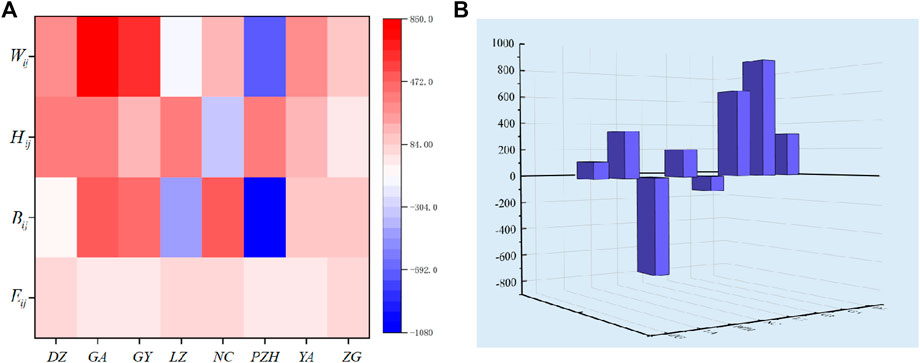
FIGURE 4. SSA calculation results for resource-based cities in Sichuan: (A) calculation results of
Figure 4; Table 3 reveal that the ranking of resource-based cities
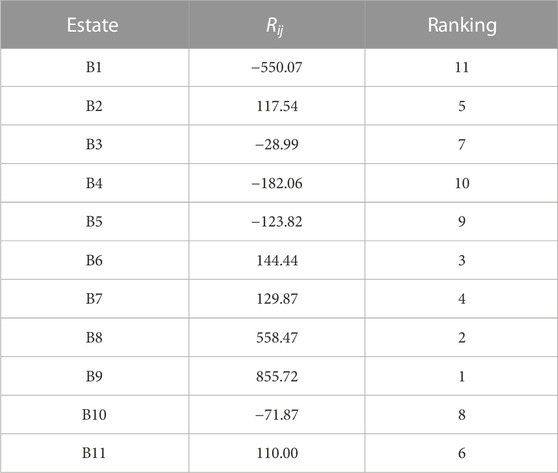
TABLE 4. Analysis of the total growth of 11 industries in mineral resources cities of Sichuan Province.
3.1.2 Analysis on the benefits of the industrial economic structure of resource-based cities in Sichuan Province
From the perspective of specific urban industries (Figure 5), the industrial economic structure of NC and PZH is exposed to the following major problems: there are no industries with a completely reasonable industrial economic structure in these cities, but there are still differences between the two cities. The reason for the unreasonable industrial structure of NC is that the competitive effect from the total amount, that is, urban industries are not competitive. The reason for the unreasonable industrial structure of PZH is the industrialmix effect, suggesting that the various industries of PZH do not match the overall development of the resource-based cities in Sichuan Province. Among the industries in the 8 cities, the B8 and B2 industries have developed relatively well, suggesting the focus of the resource-based cities in Sichuan Province on metallurgy and non-metallic ore mining and dressing.
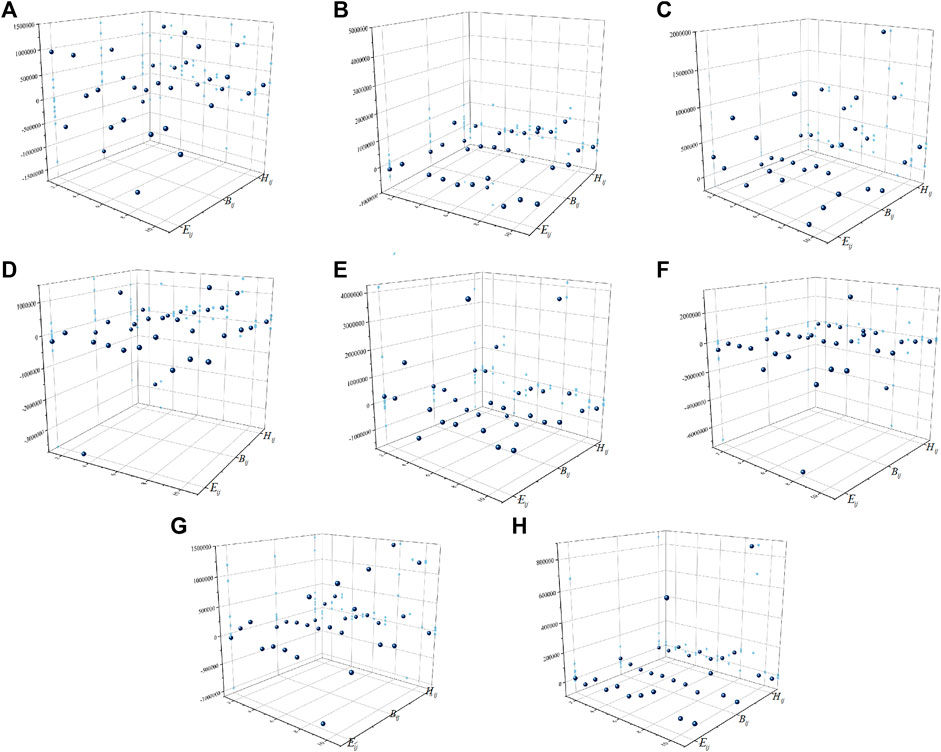
FIGURE 5. The results of the industrial economic structure of resource-based cities in Sichuan Province: (A) DZ, (B) GA, (C) GY, (D) LZ, (E) NC, (F) PZH, (G) YA, and (H) ZG.
3.2 Ecological environment analysis
3.2.1 Analysis of overall level change of the comprehensive analysis index of ecological environment
Herein, EWM was used to determine the weight. On this basis, the comprehensive analysis index of the ecological environment of resource-based cities in Sichuan Province from 2010 to 2019 was calculated using the comprehensive index model, as shown in Figure 6.
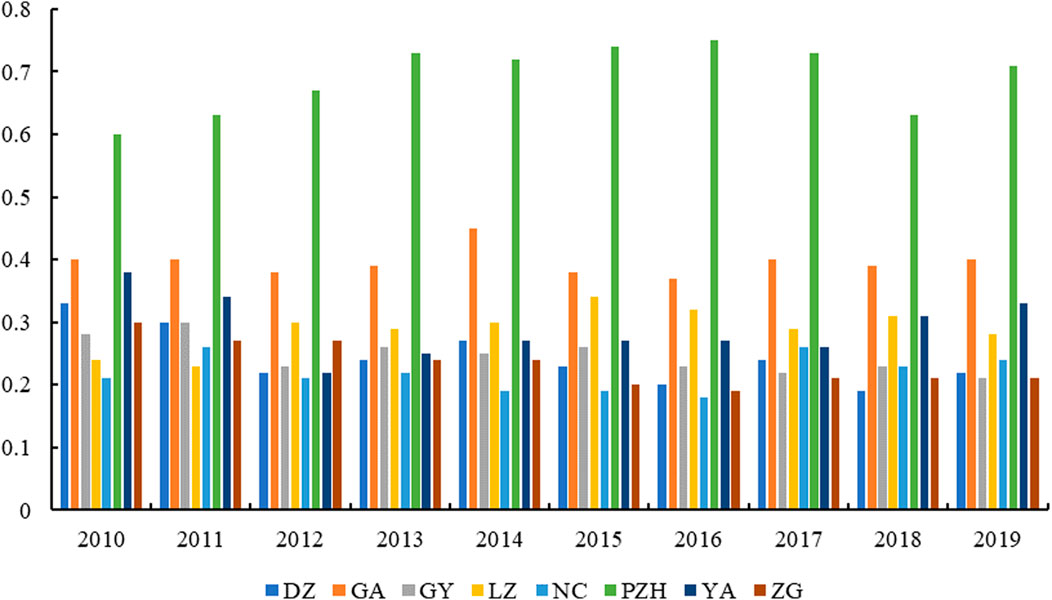
FIGURE 6. Comprehensive analysis results of ecological environment of resource-based cities in Sichuan Province.
As shown in Figure 6; Table 5, firstly, among the 8 resource-based cities in Sichuan Province, PZH has the largest comprehensive analysis index of ecological environment, followed by GA, LZ, YA, GY, DZ, ZG, and NC. The change of the comprehensive evaluation results from 2010 to 2019 reveal that the overall ecological environment of resource-based cities in Sichuan Province presents a downward trend, indicating resource-based cities in Sichuan Province overlooking the protection of the ecological environment due to economic development from 2010 to 2019. Secondly, among the 8 cities, the ecological environment status of DZ, GY, and ZG shows a downward trend year by year, while the comprehensive analysis index of the ecological environment of LZ, PZH, and YA cities exhibits an upward trend. The difference is that YA shows a “U-shaped” growth trend. Additionally, the ecological environment of NC and GA is relatively stable.

TABLE 5. Change rate of the comprehensive analysis results of ecological environment of resource-based cities in Sichuan Province.
3.2.2 Correlation analysis between the change characteristics of the comprehensive analysis index of ecological environment and the impact factors of ecological environment
In order to further analyze the ecological environment path of resource-based cities in Sichuan Province, the specific relationship between the change characteristics of the comprehensive index of the ecological environment of these 8 cities and the influencing factors were analyzed. As shown in Figure 7, C7 is the main factor affecting the ecological environment of resource-based cities in Sichuan Province.
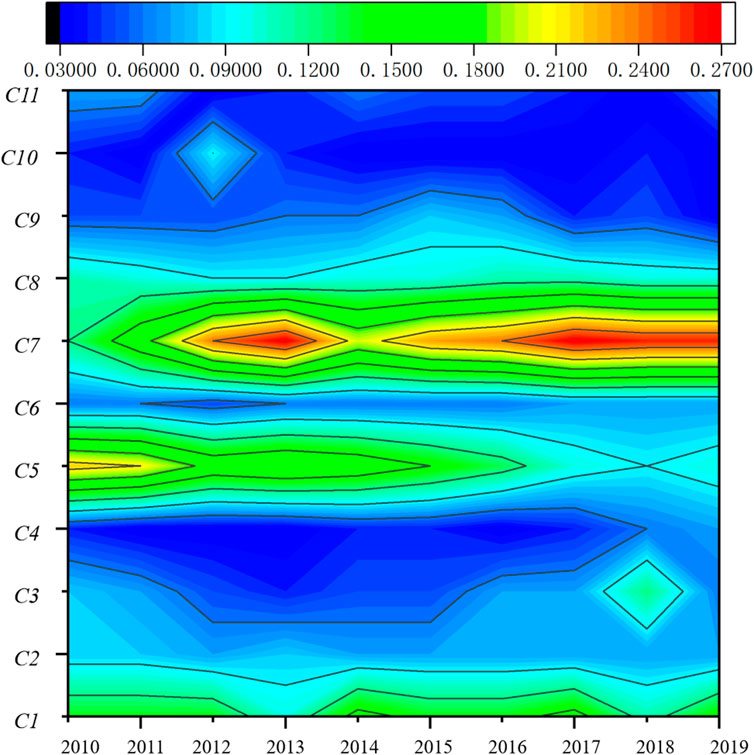
FIGURE 7. Analysis results of the importance of ecological environment impact factors in resource-based cities in Sichuan Province.
According to changes in the importance of the ecological environment impact factors in recent years, it can be concluded that: ① The impact of C7 on the resource-based cities in Sichuan Province is being continuously enhanced, although it ever declined in 2014, and the overall situation exerts a significant impact of C7 on the 8 resource-based cities; ② The impact of C5 on resource-based cities in Sichuan Province has been weakening year by year, which indicates that the total energy consumption has been relatively controlled, and all these 8 cities have gradually realized the necessity to maintain the stable development of the ecological environment for reducing the consumption of natural resources.
3.3 Research on the coupling relationship between industrial structure and ecological environment
3.3.1 Calculation and analysis of the coupling degree between industrial structure and ecological environment in resource-based cities
Herein, the calculation of the coupling degree between the industrial structure and ecological environment of resource-based cities was mainly based on the relevant data of resource-based cities in Sichuan Province from 2010 to 2019. The contribution results of each indicator were calculated using the EIS index and capacity coupling coefficient model calculation methods, and Wilcoxon was used for significance testing. The results of the two sets of data passed the test (**p < 0.005), indicating a difference between the two sets of data. At the same time, the standard deviation of the two sets of data was used for judgment, and it was found that the standard deviation of the capacity coupling coefficient model is significantly smaller than the EIS index (Table 6), indicating the good applicability of the capacity coupling coefficient model, the effectiveness of the calculation results and reasonability of the method.
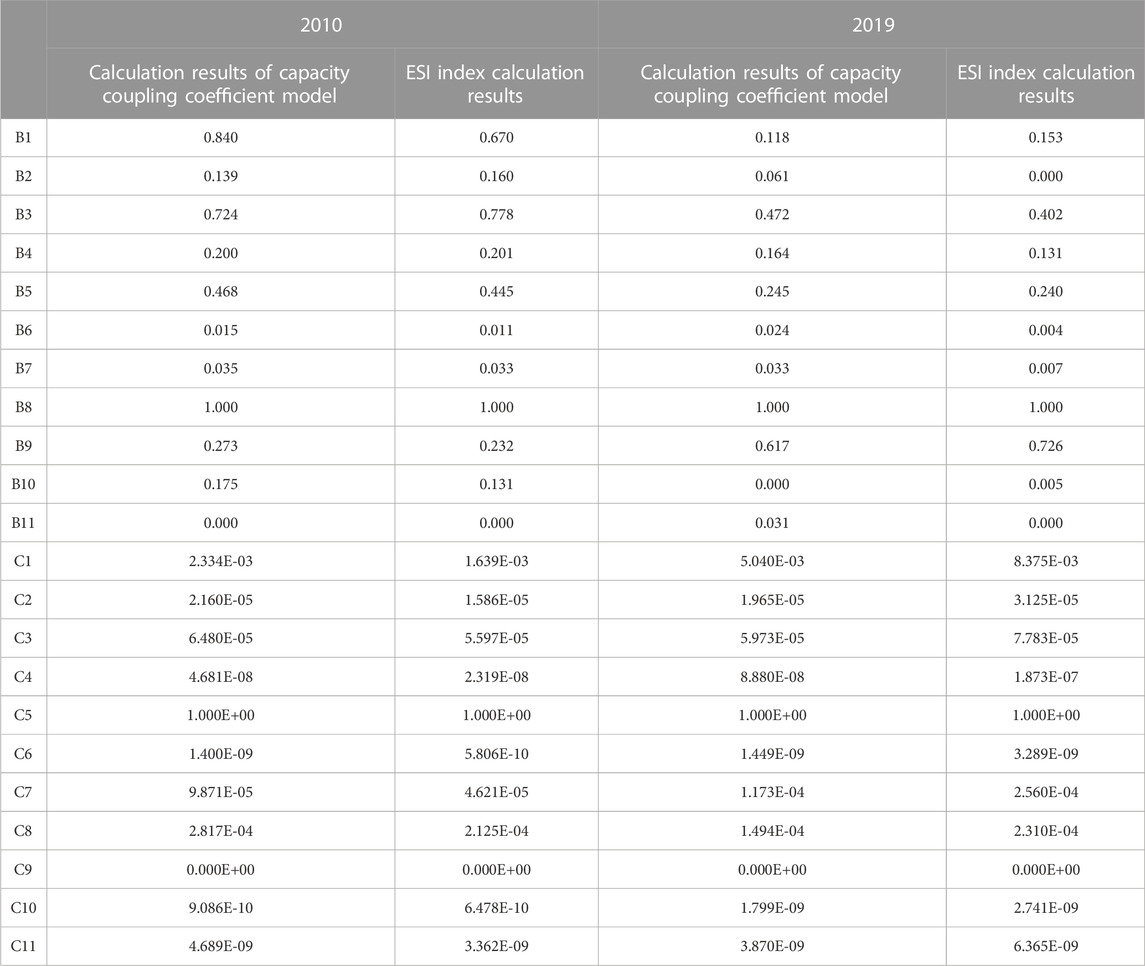
TABLE 6. Contribution results of capacity coupling coefficient model calculation and ESI index contribution results.
In the selection of the

TABLE 7. Total contribution value of industrial structure, total contribution value of ecological environment, coupling degree, and coupling coordination scheduling of resource-based cities in Sichuan Province.
It can be observed from Table 7 that the total contribution value of the industrial structure of resource-based cities in Sichuan Province was relatively stable from 2010 to 2019, basically maintaining a value above 0.290, while that of ecological environment was doubled, increasing from 0.368 to 0.752. Besides, there was a coupling relationship and interaction between industrial structure and ecological environment in resource-based cities in Sichuan Province. The coupling degree in 2010 and 2019 was 0.497 and 0.450, respectively, but this was in the initial stage of coupling, and the interaction did not reach the cut-off value of 0.6, indicating a low level of coupling between the industrial structure and ecological environment of resource-based cities in Sichuan Province, which was in the stage of spontaneous coupling. Additionally, the coupling and coordination degree between industrial structure and ecological environment of resource-based cities in Sichuan Province was 0.409 (near imbalance) in 2010 and 0.506 (barely coordinated) in 2019. The data also reveal the increasingly strengthened coupling and coordination between industrial structure and ecological environment of the resource-based cities in Sichuan Province year by year. In addition, the industrial structure and ecological environment have shifted from their disorderly development to the orderly and common development.
3.3.2 Analysis of index efficiency coefficients of industrial structure and ecological environment in resource-based cities
In order to identify indicators imposing a significant impact on the resource-based industrial structure and ecological environment systems in Sichuan Province, the growth values of the indicator efficacy coefficients of the industrial structure and ecological environment systems in Sichuan Province from 2010 to 2019 were calculated, and the results are shown in Table 8.
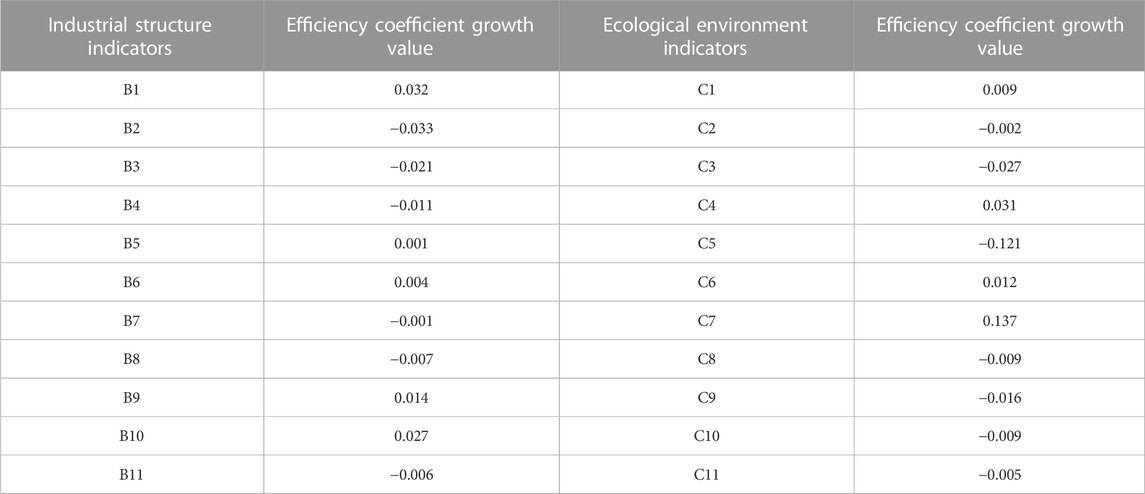
TABLE 8. Growth value of index efficiency coefficient of industrial structure and ecological environment in Sichuan Province from 2010 to 2019.
It can be seen from Table 8 that in the industrial structure, B1 and B10 have the largest growth value of the efficiency coefficient, and the contribution value is gradually prominent. Meanwhile, the growth value of the efficiency coefficient of B2 is −0.033, indicating that the contribution value of B2 decreases the most in the industrial structure. Besides, in the ecological environment, C7 is the largest indicator of the efficiency coefficient growth value, indicating that the contribution value of C7 to the ecological environment increased gradually during 2010 and 2019. On the contrary, C5 has gradually reduced its impact on the ecological environment.
4 Conclusion
This paper mainly focuses on the research of the coupling and coordinated development of resource-based cities, and summarizes the following content based on the results.
4.1 Implications to theory and practice
Summarizing the impact of the research results on theory and practice in this paper, it can be concluded that:
On the basis of existing industrial structure and ecological environment, this paper emphasizes the coupling evaluation research of resource-based cities in terms of industrial structure and ecological environment, and enriches the research content of promoting the coordinated development system of resource-based cities. At present, the evaluation of industrial structure in resource-based cities is basically based on single industry or single category industry, without sufficient attention to the specific types of industries. However, this paper integrates resource-based and non-resource-based industries, conducts research from specific types of industries, and comprehensively analyzes the two main factors affecting the coordinated development of cities, namely industrial structure and ecological environment, no longer limited to a certain type. Meanwhile, research on the coordinated development of cities has jumped out of the limitation of the national or regional level. Instead, the “resource-based city” is chosen as a type of city with high energy consumption and pollution characteristics. Overall, this study offers certain theoretical guidance significance for resource-based cities to seek a path of reform and gradually improve the level of coordinated urban development.
This paper uses panel data of cities to empirically analyze the level of urban industrial structure, ecological environment and coupling level of resource-based cities in Sichuan Province, further enriching and improving the empirical analysis method of urban coupling and coordination. The research results provide relevant decision-makers with a correct understanding of the problems in achieving comprehensive coupling and coordinated development of resource-based cities as a whole, based on which, reasonable macro policies can be formulated to provide references. The rise and fall of resource-based cities determine the economic development trend of the city and its surrounding areas. Only when resource-based cities have a suitable level of urban development, adapt to the global development trend, and gradually establish the ability to coordinate development, can they further enhance the competitiveness of the city and continue to drive the economic development of its surrounding areas. Additionally, correct policy guidance is necessarily important to improve the development level of resource-based cities. The research results of this paper have certain reference value and practical guidance for the policy-making of relevant decision-makers.
4.2 Main conclusion
By analyzing the industrial structure, ecological environment, and the coupling relationship between industrial structure and ecological environment of resource-based cities in Sichuan Province, the following inspirations can be summarized:
During the period from 2010 to 2019, GA had strong industrial development capabilities, while PZH performed poorly, which is mainly attributed to the influence of the industrialmix effect (
Within the research time frame, resource-based cities in Sichuan Province have shown an overall downward trend, while from the perspective of each city, PZH has the best ecological environment and is showing an increasing trend year by year. Further analysis of the influencing factors of the ecological environment indicates that C5 (Total energy consumption) and C7 (Industrial solid waste output) have the greatest impact on the urban ecological environment and the degree of impact changes, suggesting that the main measures for resource-based cities in subsequent ecological environment protection should be adjusted by reducing industrial waste and controlling total energy consumption.
Comparing the calculation methods of the EIS index and the capacity coupling coefficient model, the two sets of results confirm the good applicability of the capacity coupling coefficient model. Based on the calculation results of the capacity coupling coefficient model, analyzing the coupling situation between the industrial structure and ecological environment of resource-based cities in Sichuan Province, it can be concluded that the coupling degree (
4.3 Policy recommendations
Implementing stable and coordinated development in resource-based cities is not only a necessary path for the sustainable development of resource-based cities, but also an inevitable requirement for implementing ecological civilization construction. Based on the main conclusions drawn in this paper, the following targeted policy recommendations are proposed for resource-based cities:
Stable development of industrial structure is necessarily important. Industrial structure adjustment is an important issue in urban development. Adjusting and establishing a stable industrial structure can promote economic and social development as well as the material and cultural life of the citizens. Resource-based cities should vigorously develop advantageous industries on the basis of their existing resource advantages, and provide guarantees for the internal factors such as electricity, land and water consumption of enterprises in the city, so as to ensure the basic integrity of their industrial chain. Besides, efforts should be made to cultivate leading enterprises to improve industrial agglomeration, enhance the economic benefits of scale, integrate talent, technology, capital and management resources, promote the concentration of production factors towards urban advantageous enterprises and products, strengthen the integration of leading enterprises and small enterprises, promote supporting cooperative production between urban small enterprises and leading enterprises, enhance industrial agglomeration, and improve the comprehensive competitiveness of industries.
The comprehensive management level of the ecological environment should be improved. Resource-based cities should continue to consolidate the achievements of pollution permit coverage, promote the introduction of pollution prevention and control laws and pollution permit management regulations in the ecological environment, promote the establishment of a remote supervision system with automatic monitoring as the core, and organize the monitoring of industrial wastewater, exhaust gas and waste. In addition, it is necessary to conduct actual investigations on industrial enterprises, establish pilot ecological environment monitoring, integrate modern information technology with the field of ecological environment monitoring, highlight the role of modern information technology in the field of ecological environment monitoring, and establish a sound ecological environment monitoring network based on modern perception technology and big data technology. Besides, they should collaborate with surrounding cities to carry out joint prevention, control, and governance of the ecological environment, so as to form a systematic ecological environment protection system.
The layout of urban industries should be optimized. Factors affecting the development of resource-based cities are complex, and the layout should thus be optimized to promote the coordinated development of resource-based cities. The advantage of resource-based cities lies in the abundant reserves of natural resources such as coal. Therefore, resource-based cities should accelerate their development scale, actively carry out exploration, improve the scientific and technological innovation system and mechanism of the coal industry, increase their investment in research and development and scientific research platform construction in the coal industry, and strive to improve the level of clean and efficient utilization of coal. In addition to stabilizing the development of the coal industry, it is also necessary to develop industries supported by sustainable energy. The Power, heat production and supply industry plays an important role in the development of resource-based cities. Resource-based cities should, under the guidance of the management system, main laws and regulations as well as policies of the power, heat production, and supply industries, create an efficient, clean and sustainable electric heating industry without affecting the ecological environment.
4.4 Limitations of this research
The limitations of this study mainly include the following two points:
The difficulty of data acquisition results in a certain degree of subjectivity in the collection of industrial and ecological indicators in this paper. In the subsequent research process, the study focus will be placed on enriching the selection of indicators (Zuo, 2022).
In the case of using the capacity coupling coefficient model to calculate the industrial structure and ecological environment of resource-based cities in Sichuan Province, the coefficients in the model are undetermined and need to be determined through reference literature and previous research results. Besides, there are subjective factors, and in the subsequent research process, the undetermined coefficients in the capacity coupling coefficient model are objectively determined to improve the capacity coupling coefficient model. Thus, further attempts should be made to achieve a more accurate calculation of the coupling relationship between two systems (Si and Wang, 2018).
This paper fully considered the development characteristics of resource-based cities and took 8 resource-based cities in Sichuan Province as the research objects. The industrial development level and ecological environment comprehensive level of resource-based cities in Sichuan Province were respectively analyzed by using SSA and EWM. The coupling relationship between industrial structure and ecological environment was analyzed using the capacity coupling coefficient model. It has been summarized that in the subsequent development process of resource-based cities in Sichuan Province, attention should be paid to the level changes of industrialmix effect in the industrial structure, and the total amount of industrial solid waste and energy consumption should be reduced in the ecological environment. The main measures to promote the coordinated development level of resource-based cities should be to develop the coal mining and dressing industry and the power, heat production and supply industry, as well as the production and supply of electricity and heat. The research results of this paper can provide certain technical support for the research on the coordinated development level of resource-based cities, and can also provide targeted policy recommendations for the coupled and coordinated development of resource-based cities.
Data availability statement
The raw data supporting the conclusion of this article will be made available by the authors, without undue reservation.
Author contributions
Conceptualization, KL and XF; methodology, KL and XY; software, XY and YZ; data curation, XF and XY; writing—original draft preparation, XF and TF; writing—review and editing, XY; visualization, XF. All authors contributed to the article and approved the submitted version.
Funding
This work was supported by the National Social Science Fund of China (22BGL29).
Conflict of interest
The authors declare that the research was conducted in the absence of any commercial or financial relationships that could be construed as a potential conflict of interest.
Publisher’s note
All claims expressed in this article are solely those of the authors and do not necessarily represent those of their affiliated organizations, or those of the publisher, the editors and the reviewers. Any product that may be evaluated in this article, or claim that may be made by its manufacturer, is not guaranteed or endorsed by the publisher.
References
Biao, L., Jinman, W., Zhaorui, J., and Qian, T. (2020). Measurement of sustainable transformation capability of resource-based cities based on fuzzy membership function: A case study of shanxi province, China. esources Policy 68, 101739. doi:10.1016/j.resourpol.2020.101739
Chen, M., and Chen, H. (2021). Spatiotemporal coupling measurement of industrial wastewater discharge and industrial economy in China. Environ. Sci. Pollut. Res. 28, 46319–46333. doi:10.1007/s11356-021-14743-3
Dandan, Z., Junguo, L., Laixiang, S., Bin, Y., Klaus, H., Kuishuang, F., et al. (2021). Quantifying economic-social-environmental trade-offs and synergies of water-supply constraints: An application to the capital region of China. Water Res. 195, 116986. doi:10.1016/j.watres.2021.116986
Dongfang, W., Fanxin, M., Qiuling, Y., Gengyuan, L., Hui, L., Yuanchao, H., et al. (2022). Cross-sectoral urban energy–water–land nexus framework within a multiscale economy: The case of Chinese megacities. J. Clean. Prod. 376, 134199. doi:10.1016/j.jclepro.2022.134199
Fangli, R., Liang, Y., and Dan, W. (2021). Policy effects on the sustainable development of resource-based cities in China: A case study of yichun city. Resour. Policy 72, 102145. doi:10.1016/j.resourpol.2021.102145
Fu, Y., Jin, Q., Zhang, Z., Zhang, X., and Bai, W. (2021). The relationship between industrial structure and water use structure of the old industrial base in Northeast China -- taking Benxi City, Liaoning Province as an example. J. Ecol. 41 (22), 9029–9038. (in Chinese). https://kns.cnki.net/kcms/detail/detail.aspx?
Han, M., Jiang, C., and Liu, S. (2021). Multi-scale GHG emission relations in resource-based heavy industrial cities: A case study of tangshan city, Hebei province. Chin. J. Urban Environ. Stud. 09 (04), 2150023. doi:10.1142/s2345748121500238
Huijun, W., Qianqian, W., Yuhuan, X., Yuanyuan, Y., and Xiaoyu, Z. (2023). Coal life-cycle analysis embedded with land–energy nexus of a coal-based city in China. Resour. Environ. Sustain. 12, 100109. doi:10.1016/j.resenv.2023.100109
Huiyuan, L., Jun, X., Lei, Z., and Ran, H. (2022). Comprehensive quantitative evaluation of the water resource carrying capacity in Wuhan City based on the “human–water–city” framework: Past, present and future. J. Clean. Prod. 366, 132847. doi:10.1016/j.jclepro.2022.132847
Ke, S., Qiao, D., Zhang, X., and Feng, Q. (2019). Changes of China's forestry and forest products industry over the past 40 years and challenges lying ahead. For. Policy Econ. 106, 101949. doi:10.1016/j.forpol.2019.101949
Li, T., Xuran, L., Guojing, Y., Jingfen, X., Ni, Z., Dongbo, W., et al. (2021). Spatial distribution, sources and risk assessment of perfluoroalkyl substances in surface soils of a representative densely urbanized and industrialized city of China. CATENA 198, 105059. doi:10.1016/j.catena.2020.105059
Li, J., Zhang, Y., Yang, Y., Zhang, X., Zheng, Y., Qian, Q., et al. (2022). Comparative resource-environment-economy assessment of coal- and oil-based aromatics production. Resour. Policy 77 (03), 102629. doi:10.1016/j.resourpol.2022.102629
Luguang, J., Ye, L., Si, W., and Cheng, Y. (2021). Analyzing ecological environment change and associated driving factors in China based on NDVI time series data. Ecol. Indic. 129, 107933. doi:10.1016/j.ecolind.2021.107933
Malin, S., Jianlin, W., and Jiajia, Z. (2023). Effects of rising and extreme temperatures on production factor efficiency: Evidence from China's cities. Int. J. Prod. Econ. 260, 108847. doi:10.1016/j.ijpe.2023.108847
Muslim, A., Mohamad, H., Bahtiar, M., and Norshahrizan, N. (2023). Sustainability through TQM practices in the food and beverages industry. Int. J. Qual. Reliab. Manag. 40 (02), 335–364. doi:10.1108/ijqrm-05-2021-0143
Peng, L., Haijun, Z., Xi, C., Zhiqiang, W., Tao, L., Bing, S., et al. (2022). Characteristics of fine carbonaceous aerosols in Wuhai, a resource-based city in Northern China:Insights from energy efficiency and population density. Environ. Pollut. 292, 118368. Part A). doi:10.1016/j.envpol.2021.118368
Pisoni, E., Christidis, P., Thunis, P., and Trombetti, M. (2019). Evaluating the impact of "sustainable urban mobility plans" on urban background air quality. J. Environ. Manag. 231 (FEB.1), 249–255. doi:10.1016/j.jenvman.2018.10.039
Qi, Z., Henan, Y., Zaihai, Y., Jintong, G., Xiaozhuang, W., Heyong, L., et al. (2018). Energy-exergy analysis and energy efficiency improvement of coal-fired industrial boilers based on thermal test data. Appl. Therm. Eng. 144, 614–627. doi:10.1016/j.applthermaleng.2018.08.069
Qinghua, L., Peng, L., Ruhizal, B. R., Shengbin, L., Xiaoping, Z., Cheng, Z., et al. (2022). Carbon emission characteristics of resource-based cities in China. Iran. J. Sci. Technology-Transactions Civ. Eng. 46, 4579–4591. doi:10.1007/s40996-022-00876-z
Ruyin, L., Haifeng, L., Meifen, W., and Wenbo, L. (2021). Dynamic evaluation of the green development level of China's coal-resource-based cities using the TOPSIS method. Resour. Policy 74, 102415. doi:10.1016/j.resourpol.2021.102415
Shi, Y., Nan, Z., Kifayat, U., and Shuo, G. (2022). Enhancing digital innovation for the sustainable transformation of manufacturing industry: A pressure-state-response system framework to perceptions of digital green innovation and its performance for green and intelligent manufacturing. Systems 10, 72. doi:10.3390/systems10030072
Shuai, X., Lei, Z., Jun, X., Yi, D., Zhizhou, Y., and Tianci, Y. (2023). Assessment of the urban waterlogging resilience and identification of its driving factors: A case study of wuhan city, China. Sci. Total Environ. 866, 161321. doi:10.1016/j.scitotenv.2022.161321
Si, W., and Wang, C. (2018). Coupled upgrading of rural tourism industry in Sichuan Province based on capacity coupling model. Guangdong Agric. Sci. 45 (7), 8. (in Chinese). doi:10.16768/j.issn.1004-874X.2018.07.026
Sozanskyy, L. (2020). Comparative assessment of the inter-sectoral communications of the light industry of Ukraine and the certain countries EU. Socio-Economic Problems Mod. Period Ukraine 1 (141), 52–56. doi:10.36818/2071-4653-2020-1-8
Sun, Y., and Liao, W. C. (2021). Resource-exhausted city transition to continue industrial development. China Econ. Rev. 67, 101623. doi:10.1016/j.chieco.2021.101623
Wan, S., Luan, W., and Lin, Q. (2021). Industry linkage, spatial correlation, and city exports: Case study of the textile and clothing export industry in China. Ann. regional Sci. 66, 91–112. doi:10.1007/s00168-020-01011-4
Wang, D., Shi, Y., and Wan, K. (2020). Integrated evaluation of the carrying capacities of mineral resource-based cities considering synergy between subsystems. Ecol. Indic. 108, 105701. doi:10.1016/j.ecolind.2019.105701
Wang, T., Zhang, J., Yu, X., Liu, B., and Chen, P. (2021). Sustainable development pathway of resource-based cities: A case study of taiyuan innovation demonstration zone for national sustainable development agenda. China Popul. Resour. Environ. 31 (03), 24–32. https://kns.cnki.net/kcms/detail/detail.aspx?
Wang, Y. (2022). Development characteristics, influencing mechanism and coping strategies of resource-based cities in developing countries: A case study of urban agglomeration in northeast China. Environ. Sci. Pollut. Res. 29, 25336–25348. doi:10.1007/s11356-021-17820-9
Wu, J., and Bai, Z. (2019). Explanation of the differences in the urbanization development of resource-based cities in China: Based on the shapley value decomposition method China. Land Sci. 33 (12), 72–79. (in Chinese). https://kns.cnki.net/kcms/detail/detail.aspx?
Xing, M., Luo, F., and Fang, Y. (2021). Research on the sustainability promotion mechanisms of industries in China's resource-based cities —— From an ecological perspective. J. Clean. Prod. 315, 128114. doi:10.1016/j.jclepro.2021.128114
Xinyue, F., Bin, L., Kai, W., Tingting, F., and Zhongli, Z. (2023). Research on the spatiotemporal characteristics of recc in resource-based cities based on the EWM-CPM: A case study of sichuan province, China. Ecol. Indic. 147, 109979. doi:10.1016/j.ecolind.2023.109979
Xiuzhi, H., Jingru, L., and Guangming, S. (2023). Urban industrial solid waste metabolism based on ecological network analysis: A case study of tianjin. Clean. Responsible Consum. 9, 100117. doi:10.1016/j.clrc.2023.100117
Xu, M., Wang, S., Lund, H., and Kaiser, J. (2021). Towards energy conservation by improving energy efficiency? Evidence from China's metallurgical industry. Energy 216, 119255. doi:10.1016/j.energy.2020.119255
Yang, H., Zhai, G., and Zhang, Y. (2020). Ecological vulnerability assessment and spatial pattern optimization of resource-based cities: A case study of huaibei city, China. Hum. Ecol. Risk Assess. 11, 606–625. doi:10.1080/10807039.2020.1744426
Yang, Y., Jun, N., and Atif, J. (2023). An evaluation of the energy-related carbon dioxide emissions from China's light sector to achieve sustainable development goals. Eval. Rev. 5, 1–25. doi:10.1177/0193841X231164880
Yanqi, Z., Rongkun, D., Ying, Y., Fan, L., Yue, Z., and Xinyi, W. (2022). Integrated evaluation of resource and environmental carrying capacity during the transformation of resource-exhausted cities based on euclidean distance and a gray-TOPSIS model: A case study of jiaozuo city, China. Ecol. Indic. 142, 109282. doi:10.1016/j.ecolind.2022.109282
Yong, X., and Chuansheng, W. (2020). Ecological protection and high-quality development in the yellow river basin: Framework, path, and countermeasure. Bull. Chin. Acad. Sci./Chung-kuo ko Hsueh Yuan Yuan Kan 35 (07), 875–883. doi:10.16418/j.issn.1000-3045.20200425002
Yu, C., Li, H., et al. Yu, C., Li, H., Jia, X., and Li, Q. (2015). Improving resource utilization efficiency in China's mineral resource-based cities: A case study of chengde, Hebei province. Conservation Recycl. 94, 1–10. doi:10.1016/j.resconrec.2014.10.013
Yu, J., Li, J., and Zhang, W. (2019). Identification and classification of resource-based cities in China. J. Geogr. Sci. 29, 1300–1314. doi:10.1007/s11442-019-1660-8
Yuan, Y., Bai, Z., Zhang, J., and Xu, C. (2022). Increasing urban ecological resilience based on ecological security pattern: A case study in a resource-based city. Ecol. Eng. 175, 106486. doi:10.1016/j.ecoleng.2021.106486
Yue, L., Ying, Q., Zhen, L., and Wenhua, W. (2020). Multi-sector reduction potential of embodied carbon emissions in China: A case study of liaoning province. Environ. Dev. Sustain. 22, 5585–5602. doi:10.1007/s10668-019-00441-1
Yufeng, C., and Longshan, L. (2022). Improving eco-efficiency in coal mining area for sustainability development: An emergy and super-efficiency SBM-DEA with undesirable output. J. Clean. Prod. 339, 130701. doi:10.1016/j.jclepro.2022.130701
Yuying, Y., Haixiang, G., Linfei, C., Xiao, L., Mingyun, G., and Xiaoling, K. (2019). Regional analysis of the green development level differences in Chinese mineral resource-based cities. Resour. Policy 61, 261–272. doi:10.1016/j.resourpol.2019.02.003
Zhang, S., Gu, J., Chen, J., Wang, L., and Yang, H. (2022). Effects of netrin-1 and NHE1 participation on the migration of macrophages driven by CCL2. Mod. Econ. Sci. 44 (03), 111–116. doi:10.14715/cmb/2022.68.6.18
Zhang, J., Zhang, C., Shi, W., and Fu, Y. (2018). Quantitative evaluation and optimized utilization of water resources-water environment carrying capacity based on nature-based solutions. J. Hydrology 568, 96–107. doi:10.1016/j.jhydrol.2018.10.059
Zhaorui, J., and Jinman, W. (2020). Sustainable development evaluation of the society–economy–environment in a resource-based city of China: A complex network approach. J. Clean. Prod. 263, 121510. doi:10.1016/j.jclepro.2020.121510
Zongrun, W., Haiqin, F., and Ling, Z. (2023). Multiple urban resilience evaluation of resource-based cities’ sustainable transformation effect. Resour. Conservation Recycl. 191, 106912. doi:10.1016/j.resconrec.2023.106912
Zou, H., Duan, X., and Jin, T. (2022). Urban chemical industrial cluster area restructuring and determinants: A case study of a typical old chemical industry area along the yangtze river, China. Chin. Geogr. Sci. 32, 237–250. doi:10.1007/s11769-022-1267-3
Zuo, H. (2022). Research on agricultural economic development of Shanxi Province based on deviation-share analysis. Agric. Resour. Regionalization China 06, 218–228. https://kns.cnki.net/kcms/detail/detail.aspx?
Keywords: resource-based cities, industrial structure, ecological environment, shift-share analysis, capacity coupling coefficient model, coordinated urban development
Citation: Liu K, Fan X, Yang X, Zhang Y and Feng T (2023) Research on the coordinated development of resource-based cities in Sichuan Province: from the perspective of industrial structure and ecological environment. Front. Environ. Sci. 11:1194584. doi: 10.3389/fenvs.2023.1194584
Received: 27 March 2023; Accepted: 19 July 2023;
Published: 27 July 2023.
Edited by:
Ghaffar Ali, Shenzhen University, ChinaReviewed by:
Shi Yin, Hebei Agricultural University, ChinaNatasha Murtaza, University of Agriculture, Faisalabad, Pakistan
Copyright © 2023 Liu, Fan, Yang, Zhang and Feng. This is an open-access article distributed under the terms of the Creative Commons Attribution License (CC BY). The use, distribution or reproduction in other forums is permitted, provided the original author(s) and the copyright owner(s) are credited and that the original publication in this journal is cited, in accordance with accepted academic practice. No use, distribution or reproduction is permitted which does not comply with these terms.
*Correspondence: Xinyue Fan, RmFuWGlueXVlXzIwMjBAMTYzLmNvbQ==
 Kexin Liu1
Kexin Liu1 Xinyue Fan
Xinyue Fan
